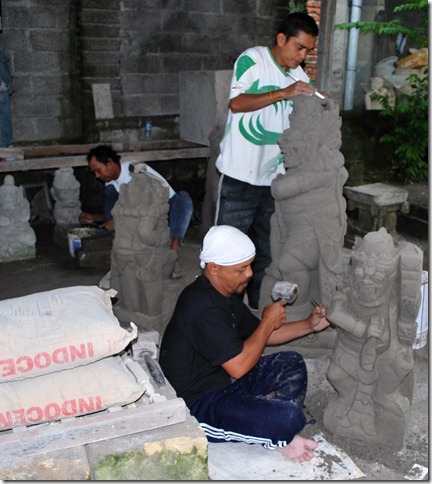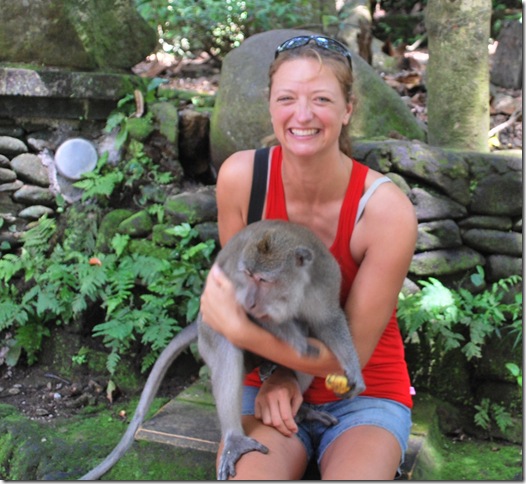The last couple of days into Christmas Island were looking like they were going to be uneventful. The spinnaker conditions continued, and by Thursday morning it looked like we were going to be in by sunset if we could just keep up 6 knots. That’s usually fairly fast for us, but in the trades with a favorable current, we’d been making good time. Unfortunately, the wind started to die down a bit and left us with only about 5 knots. No problem. We decided to just put the main up in addition to the spinnaker. That’s pretty common on a monohull, but on a cat, the cap shrouds keep the boom from swinging very far out, so we usually don’t bother with it. It all went great for the first hour or so, and then I looked out through the hatch in the salon and saw the spinnaker stalled and starting to wrap around the forestay. By time I got out to the foredeck it was too late. All I could really do was watch the spinnaker keep wrapping itself around the forestay as the wind swirled off of the main. We eventually dropped the main to stop the funny wind eddies, but it didn’t help free the spinnaker. It was wrapped at the top and bottom, just out of arms reach, and the middle was filled with wind, holding it tight. After several failed attempts to pull it loose (it was wrapped so tight that even loosening the halyard did nothing), we finally started the engine did the only thing that seemed to work – motor in circles in the opposite direction and let the wind unwrap it. That worked like a charm until it came to the last wrap or two, when enough of the spinnaker had come unwrapped that it just started getting caught on the spreaders and mast instead of unwrapping. We finally untied both sheets and then manually unwrapped the last couple of turns before dropping the spinnaker on the tramp. The sock has a couple of tears, but other than that, it seems to be OK. Just as I was trying to untangle the whole mess piled in the trampoline and still tied around the forestay, an Australian customs plane buzzed us. Lauren provided the standard info over the radio, while I was hoping that they didn’t know anything about sailing.
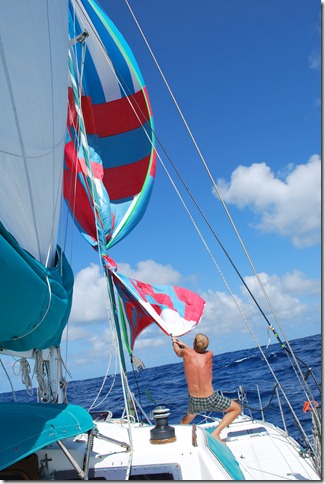 Let’s just say I didn’t win that round
Let’s just say I didn’t win that round
We motorsailed the rest of the way in and entered Flying Fish Cove a couple of hours after sunset. The water is so deep here that the depth sounder, which only works down to about 400 feet, didn’t register anything until we were nearly a stone’s throw away from the waves crashing on the cliff at the southwestern edge of the cove. Using a spotlight, we were able to find a mooring and get tied up securely with the rocky cliff less than 100 feet away.
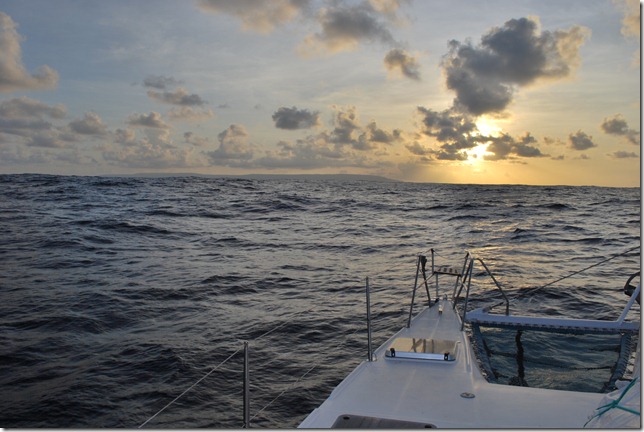 Closing in on Christmas Island at sunset
Closing in on Christmas Island at sunset
When we woke up we looked around to find ourselves in a cove that was beautiful even with the phosphate loading apparatus that takes up a fair part of the shoreline on the eastern side of the bay. Beautiful white and yellow birds with long tails floated above the boat with many more resting in the treetops on the steep hillside towering above the bay. The water below us was so clear that we could easily see the details of the coral more than 20 feet below. Swimming beneath and around the boat was a school of well over 100 Indian Triggerfish that continued to swarm around us when we jumped in for a snorkel. Niue was the last place we visited with such clear water and an underwater topology like this one, where you can snorkel over beautiful, relatively shallow coral with colorful reef fish darting about and then less than 100 yards away look over the edge into the deep blue featureless abyss. As I gazed at the dropoff, I saw several large trumpetfish just floating above the coral, lots of smaller, colorful reef fish, and then a large Napolean Wrasse, as big as the ones on the Great Barrier Reef just rambling along at about 30 feet.
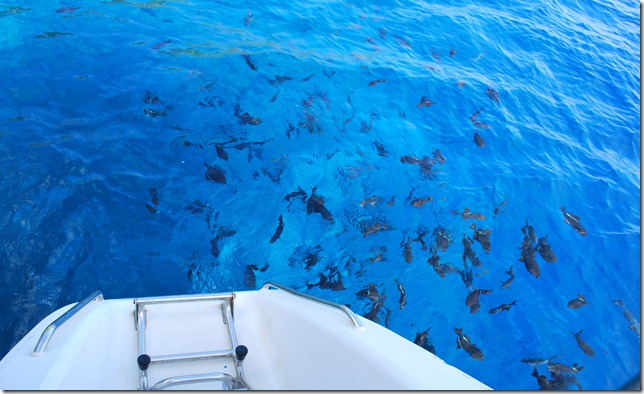 Large school of Indian Triggerfish at the stern
Large school of Indian Triggerfish at the stern
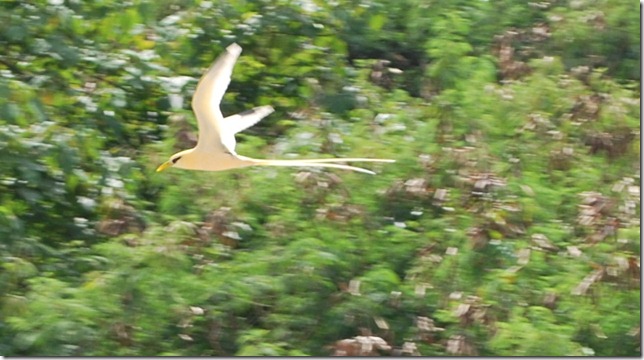 A common site at Flying Fish Cove
A common site at Flying Fish Cove
Customs came out after our snorkel and cleared us in during what was probably the most pleasant official visit we’ve had. Islands really do seem to have a nice effect on people. They filled us in on all the social goings on this weekend and gave us some tips on sights to see. We also had a chat about the island’s inhabitants. If my memory is correct, there are about 1200 “locals”, 2400 refugees in a detention camp on the northwest point, and about 600 people working the detention camp. Refugees from boats that are intercepted in the Torres Strait are brought here, and realizing that, some refugee boats come directly here where the passengers are processed and taken in busses to the camp. The boats are then taken 10 miles offshore and destroyed. The refugees are primarily Afghan, Iraqi, Iranian, and Sri Lankan. Apparently many of the Afghan refugees are from the minority Afghan Hazara ethnic group and are now being sent back to Afghanistan. After just reading The Kite Runner on this passage, which includes stories about how the Hazara have been treated in Afghanistan, and hearing about what nice people they are from one of the visiting officers, it’s a little sad to think of them being sent back.
Once cleared in, we had a nice bike around a small portion of the settlement on the northern portion of the island. In many ways, it is a typical small island town – people are friendly, everything is expensive (pizzas were $3-5 in Bali and are $15-20 here in a cafe), the bank has no ATM, but there’s one a shop at the top of the hill, there are two popular pubs, and the internet is agonizingly slow (it could be a long time before we can put up pictures). We had a chat with the a divemaster at one of the two local dive shops and heard some great stories about diving with whale sharks (about 150 were spotted last season) and many other species of large sharks including tigers and hammerheads. He told us to enjoy the wall diving here but to keep an eye on the deep blue as well for the occasional surprise that materializes. Apparently the hammerheads are especially cheeky and shy. They like to get very close to divers to check them out when they aren’t looking, but quickly swim away when you turn to look at them. This is likely to be a short stop for us, but we’re really looking forward to exploring the island and its residents.
Lat: 10 11.532′ S
Long: 110 14.738 E
It is Tuesday night around 10 p.m., and we are cruising along at almost 7 knots. We started flying the spinnaker yesterday around sunset and will probably be able to keep it up for the rest of the passage. The motion is easy, the skies are clear and starry, and we are looking forward to arriving at Christmas Island in a couple of days, just in time for the weekend.
Dallas planned our route according to the predicted weather, and it seems to have paid off. The GRIB data predicted that there would be very light winds north of 10 degrees south but steady trades from 10 and below, so we took advantage of the moderate southeasterly winds and calm seas on Sunday and early Monday to sail a beam reach on a southwesterly course. Once at 10 degrees, we changed to a westerly course to get on the rhumb line. We added on a few more miles this way but haven’t had to motor except for the first few hours getting around the island of Bali.
We met an Australian at a warung in Bali last weekend who is responsbile for monitoring daily usage of water, fuel, etc. on a tugboat operating around Indo. He was really curious about our fuel usage, and Dallas broke it down for him like this: we’ve used about 800 engine hours in 15,000 miles. It’s easy to take the wind for granted, especially these wonderful trade winds that just keep pushing us west, but figures like that really put it into perspective.
We’ve had a couple of unusual occurrences on the passage. (Dallas spotted some dolphins, but at this point, I wouldn’t say that’s unusual!) One was a few lights blinking on the port horizon that were clearly markers of some kind but were not on our charts. There were two blinking red lights about a half a mile apart and then a bright white light that was probably the oil rig or whatever was being marked by the red lights. I thought this was strange, but Dallas was especially curious about them since he’d spent much of the day reading Orwell’s 1984 (they’re not on the charts…what could this mean?). Most of the time we are both pretty nonchalant about being in the middle of the ocean, but when reading a book or watching a video that gets our nervous system going, we tend to be a little more nervous about our surroundings as well.
The other unusual occurrence was last night when I was lying in bed and heard a strange noise. I thought a wave had come through the open hatch and was relieved that I wasn’t lying directly underneath. However, the noise continued, and it wasn’t until I turned on the light that I discovered that a flying fish had managed to fly right into the narrow opening between the hatch and deck! I quickly took my leave from the berth, and Dallas came down and kindly disposed of the wiggly fish.
Our last few days in Bali haven’t been too adventurous, but they’ve been productive. Boat jobs never end, so we’ve sweated our way through a day or so of different repair and maintenance jobs – changing engine oil (every 100 engine hours), tightening belts, repairing a broken VHF antenna, fixing a leak, etc. Lauren took me up the stick as well so I could have a look at the rigging before we start our Indian Ocean crossing. I didn’t see any major problems, although the standing rigging (stainless wires & fittings holding up the mast) could use a good polish. It’s amazing how much even good quality stainless steel rusts in a year and a half under these conditions. I also replaced the shackle for the spinnaker halyard block at the top of the mast. The last time I did it was at sea during our long crossing in the Pacific and doing it in a calm anchorage was much, much simpler. It’s stainless as well, but it is fastened through a larger stainless eye and they wear against each other. It wasn’t too worn, but it was enough that I’d rather start the ocean crossing with a new one.
We needed to check out and make an ATM stop, and one of the locals here told us to try using the ATM at LotteMart, which was on the way, so we stopped there to check it out. It looked like a local Wal-Mart Supercenter, so we were pretty excited about doing some provisioning there. We tried to ask our cab driver about whether it was cheap or expensive, but he didn’t speak much English. After a couple of failed attempts, I tried “LotteMart: big money or small money?” He cracked a big smile and said “Small money”, which was consistent with the large number of locals shopping there, so we decided to come back.
Check out was pretty smooth. It took us about half the time we were expecting, everyone was friendly, and as before there were heaps of stamps, but the only cost was $2 at quarantine. This time we knew the Navy office was in Serangan so we made the visit to the Navy office first then went to Benoa to complete the process. Apparently this is a little out of order, but not too big of a deal. We just smiled a lot (bringing Lauren along seemed to help), used the local phrases we’ve learned, and made small talk. We finished in time to have a small lunch at Bali Marina, where we’d spent our first night in Bali. After traveling a bit, we were shocked at how high their prices were.
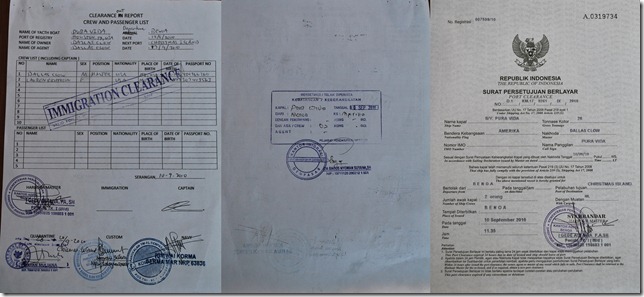 13 stamps and 6 signatures later, we are cleared for departure
13 stamps and 6 signatures later, we are cleared for departure
Yesterday was the last day of Ramadan, and although Bali is mostly Hindu, Indonesia is the world’s most populous Muslim country. Apparently many of the fishermen are Muslim (the Hindus do believe the sea is the home of evil spirits) because all of the marine shops near the marina were closed, and the harbor was filled with more fishing boats than I’ve ever seen in one place in my life. We didn’t have the camera, but it would have been hard to capture the sight anyway. There were literally hundreds of boats tied alongside each other filling the harbor – colorful blue, red and purple wood-hulled boats, white steel ones, the rows just went on and on. These weren’t small fishing dhows; they were large 70’-100’ offshore boats. Apparently they were all in town to celebrate Ramadan and it was a sight to see.
The shopping at LotteMart turned out to be pretty good. We got a number of things we needed, enjoyed some good local prices, and even found a new pressure cooker. The pressure cooker is one of the more important galley items and the seal had stretched too much on ours to make it useful anymore. We thought we could find a new one in Australia, but when we asked for pressure cookers there they always pointed us to electric gadgets. Here we were able to find 5 models of old-fashioned pressure cookers on display. We selected the one model that was actually in stock and continued the process of walking down every aisle to make sure we didn’t miss anything. We’re not expecting much in the way of shopping until South Africa so we’re pretty stocked up at this point.
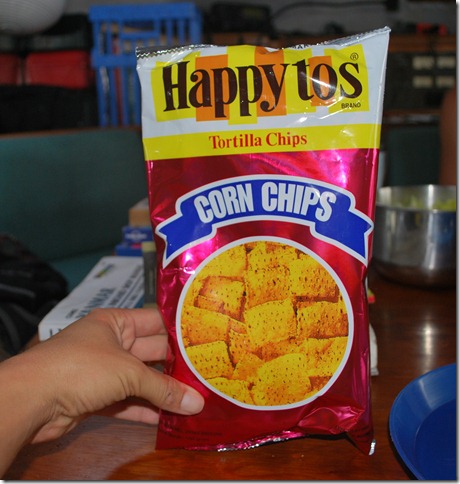 Typical Asia: No Fritos, but how about some Happytos?
Typical Asia: No Fritos, but how about some Happytos?
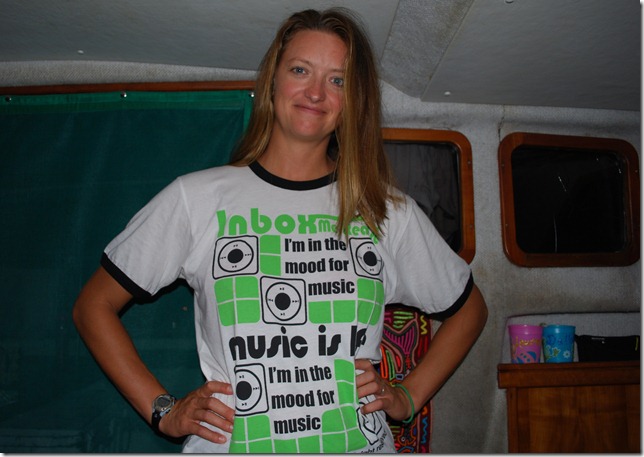 Bargain threads are looking good…
Bargain threads are looking good…
After another hot, lazy day on the boat (at least Lauren got in a little beach time), we’re finally ready to set off. The typically reliable tradewinds have been displaced a bit recently by what looks like the ITCZ moving quite a ways south, but it should start clearing up soon and we’re hoping for some decent sailing to Christmas Island. We have about 5500 miles to go before we’re safe in South Africa and out of the cyclone region, so I’m anxious to get started, especially as there’s not really any padding left in our schedule and something always seems to cause delays.
We’ll definitely miss Bali with its kind and friendly people, beautiful temples and mountains, nice beaches, cheap everything, and laid-back atmosphere. Goodbye in Indonesian is a bit different than it is in English. There are two translations of the phrase. One, “selamat jalan” is said to the person who’s leaving (by the person who’s staying). The other, “selamat tinggal” is said by the person who’s leaving to the person who’s staying. “Selemat tinggal” Bali!
Well, you might think that once you’ve been climbed by monkeys, it’s all downhill, but each day here has brought new and interesting experiences. On Saturday as we were returning to Kuta from Ubud on the bike, it started to pour down rain just as we arrived at the place we had been thinking of stopping — Batubalan, the village known for stone carvings. It seems that most of the major villages between Ubud and Kuta are known for a particular type of craft, with many people within the village involved in that activity. For example, we drove through one village that was renowned for egg painting and had at least five street-side studios/shops where eggs could be purchased right next door to each other. It seems like this would create competition amongst neighbors and friends, but then again, the Balinese seem to be very community-oriented and have temples, conservation projects, etc. that are funded by local villages. But I digress…
We made our way through three different shops that were chock full of stone carvings. Each one had its own selection of unique items, but there were several smaller items that each one had in common that must be typical souvenirs for tourists such as little praying Asian dolls and wall hangings with flowers. Surprisingly, they did not have any statues of the male anatomy or couples in sexual positions, as almost every souvenir shop in Kuta (and to a lesser extent, Ubud) had several of these in wood, often with a bottle opener attached to the end. We’re not completely sure what this is about but think they must be a gimmick to get drunken Aussies who aren’t into art to spend their money on carvings. Anyway, we picked up a framed relief (3-D) wall-hanging of a holy ceremony that looks like it has been around for 300 years, along with some smaller items for gifts, and loaded them onto the bike — one bag between Dallas legs, the relief in my lap, and another somewhat heavy bag in my hands. We had as much as we could possibly transport and left the Batubalan villagers looking very pleased.
These sculptors are working with cement, but limestone is also used 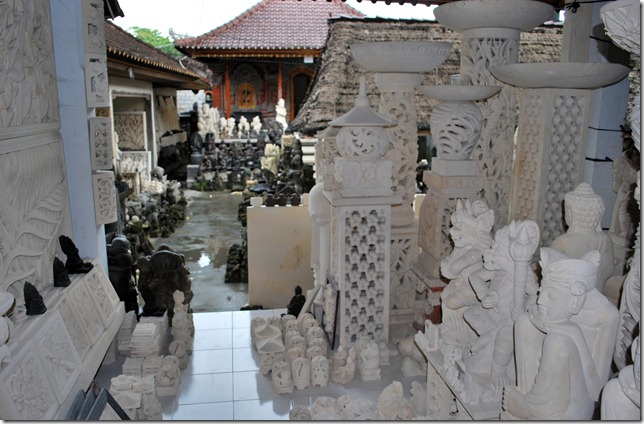 At least we didn’t try to transport one of the really big ones
At least we didn’t try to transport one of the really big ones
As we drove away, Dallas said, “Just don’t move around. With all of that weight back there, it seems more unbalanced”. Great! Then we’re all set for our trip through the big city of Denpasar! We hadn’t gone through the city yet, and it was an all new adventure. Fortunately the rain had stopped! The two lane streets were three or four vehicles thick, with scooters squeezing into very narrow spaces between cars and curbs. Naturally Dallas, having a whole 24 hours of experience on the streets of Bali under his belt, was right there with them, and I had to use caution when we were stopped at the lights and inching forward in the pack to make sure I didn’t scrape the adjacent cars with the stone carving in my lap. When I mentioned this to Dallas later, he said, “Oh, I thought you would just hold it upright.” Apparently Mr. Practical didn’t realize how heavy it was, but he did a great job navigating through the traffic, and only once did I question his judgment when it appeared that we were headed into oncoming traffic (we turned eventually). We made it back to Kuta with sore buns but in one piece and thoroughly enjoyed our $4/hour full-body massages that afternoon!
We stayed in Kuta for the rest of the weekend to enjoy the beach and the nightlife. I love the surf culture here as well as the great relationship between the Balinese and the tourists, many of whom stay for weeks or even months at a time. I was starting to feel pretty darn comfortable in our little room by the beach, but alas, we had to go. Before heading back to the boat on Monday, we ran some errands to collect things we will need in Africa — passport photos (10 each, I guess they require them for everything there), copies of the new boat registration certificate, and t-shirts and balls for trading/gifts. If you have to leave a place you’d rather not, it’s a blessing to have something else to look forward to, and I think Dallas and I are both pretty psyched up for Africa at this point.
It was nice to be off the boat for a while, and I guess we stayed away long enough, because I was happy to see her again. It was fun to come back to Serangan, too. Even though we’ve only been here a short time, it’s such a small village that you start to see the same friendly and familiar faces. Today one of the villagers is doing some cleaning and waxing of the boat for $20. It’s a win-win for him and for us, and he’s been great to have around. He just asked us if it was ok for him to smoke a cigarette in the cockpit and told us that he started smoking after seeing Slash from Guns and Roses smoking while playing the guitar! Of all the reasons for a man in a small village in Indonesia to start! Of course his continued habit probably has something to do with cigarettes only costing $1/pack here.
Tuesday was a rough day, particularly for Dallas. He woke up the night before with a temperature of 103 and full body aches and pains. He was in pretty bad shape throughout the morning, alternating from fever to chills. Our mariner’s medical guide said that if traveling in malaria-infested areas, attribute fever to malaria unless proven otherwise, so that afternoon we took a taxi to an Australian-run medical clinic for tourists to get him checked out. In addition to malaria, they also ran tests for dengue fever and a couple of other things, all of which came back negative except for one that was a possible indicator of dengue. If you aren’t familiar with dengue, try to keep it that way. It is a nasty illness that you get from mosquitoes in Southeast Asia. We’re pretty sure Dallas had it a few years ago after we returned to the States from Thailand, and he was fighting a high fever for almost a week and still recovering a week after that. (Fortunately it didn’t progress to its most severe form, which involves internal bleeding.) Needless to say, we were really hoping that he didn’t have it again, and based on his seemingly swift recovery (his fever broke last night and hasn’t returned), it looks like he’s in the clear.
Last night we returned to Kuta to pick up our new eye glasses. I’ve never had glasses before, but my vision ain’t what it used to be, and at these low prices ($75 for an exam, lenses and frames), I thought what the heck. Maybe it will help me restore my image as a serious, professional woman when the time comes! Ha! Dallas was also pleased to get some new ones since his last pair broke on our passage to Vanuatu, and his soldering fix didn’t take. Since then he’s been using contacts as well as a really old pair that he can now return to its rightful owner, Harry Potter!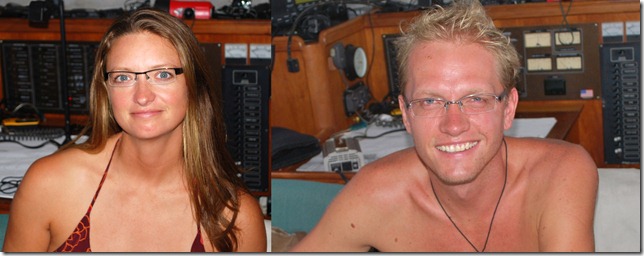
Our most practical souvenirs from Bali
From Kuta, we caught a taxi to head up the road to Seminyak, the Beverly Hills of Bali. We were pretty surprised at just how upscale it was, a completely different scene from Kuta. The Italian restaurant we selected had excellent food (mmmm, salmon…my favorite!) and service. They even brought out a complimentary appetizer and after-dinner cordial. Big thanks to Dallas’ brother Tim for the meal! It was a rare treat!
We are working on the boat this week and getting ready to set sail on Saturday, weather permitting. For two days we’ve had very light winds and rain, and the GRIB data is predicting more of the same until late next week. We’d prefer not to have to wait to depart but don’t want to motor all the way to Christmas Island, either, so we’ll see…
Ubud is famous for being the spiritual, cultural and artistic center of Bali. In addition to being a tourist destination, it also seems to be home to a fair number of expats with a disproportionately large number of them being keenly interested in yoga, meditation, tantric breathing, baggy clothes in earth tones, organic foods, dog shelters, etc. I can’t really poke fun at all the upscale culturally sensitive Westerners there since I’m a vegetarian whose wife enjoys yoga (it is pretty cool to watch) and I was also interested in visiting Ubud (and who doesn’t love dogs), but it is an interesting crowd that we really haven’t seen much of on our travels.
We’ve taken in a traditional dance performance at nearly every country we’ve visited, and it was at the top of our Ubud to-do list. Without really knowing anything about the layout of Ubud we managed to drive into town and park right across from a temple that was starting a traditional dance performance show in 15 minutes. We bought a couple of tickets, found some gelato to stave off our hunger for another hour or so and then took our seats in the temple. In case it’s not clear from the pictures, the temples here come in a few different flavors, but a common one is a stone construction featuring a large rectangular space with a raised floor that is open on three sides, pillars holding up a red tile roof, and an ornate facade at the back of the temple behind a stage-like area. In this case, we sat on chairs in the large open space while the show was on the stage. The left and right sides of the stage were filled with musicians making up a sort of small orchestra. With the exception of one flute player and four female singers, all of them played some type of percussion instrument. There were drums and gongs, bell-like instruments, Balinese xylophones, and a simple wooden percussion instrument player that seemed to be keeping the main rhythm for the whole affair. At times it sounded pretty good, but most of the time it sounded like a cacophony bordering on chaos. I guess it’s an acquired taste. Either way, the skill of the musicians was pretty impressive. They probably do this twice a week, but they played for nearly two hours without a single piece of written music, no director waving hands and arms in front of them, and didn’t seem to ever miss a note. Often the guys playing the most difficult and quick pieces on the more complex instruments would be looking off into the distance with an expressionless face while the little carved hammer in their right hand flew over the top of the instrument, striking it at different angles in perfect time with the other players beside them.
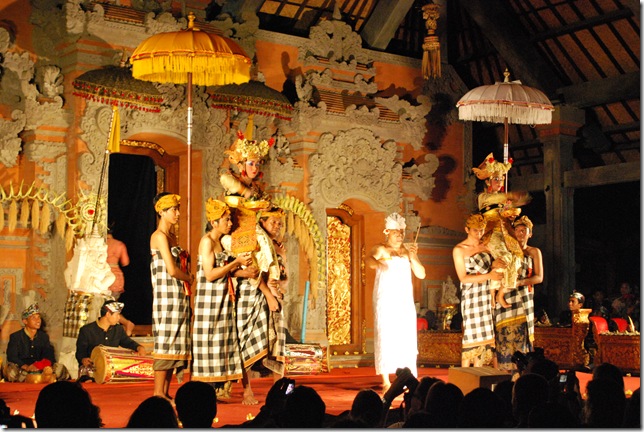 You know you’ve arrived when you have two guys to carry you and one to hold your umbrella
You know you’ve arrived when you have two guys to carry you and one to hold your umbrella
I wish I could say as much for the dancing and acting. At least the costumes were colorful and entertaining. It seems like if you’re a participant playing a demon or some other role that involves a mask then you get to dance around like a jester and try to mime the storyline. The dancers that didn’t wear masks generally had very slow motions featuring lots of hand and arm contortions, strictly defined poses, slow turns of the head to particular angles, etc. The first dance featured two female dancers whose movements weren’t too entertaining, but the degree to which they stayed synchronized in their motion was pretty impressive, especially considering the complex and arrhythmic sounds from the orchestra as well as the fact that they often had their eyes closed or weren’t facing each other. Lauren is the official dance critic (I often catch her making breakfast with her legs in some sort of a dance pose) and she wasn’t impressed either. Maybe we’re just spoiled by the simple, emotive Polynesian dances or maybe it’s the stereotypical Asian restraint in terms of self-expression. There’s no doubt that the Balinese society is much more modernized, developed, and complex than the indigenous societies of the Pacific Islands, but the Legong dance wasn’t our favorite example.
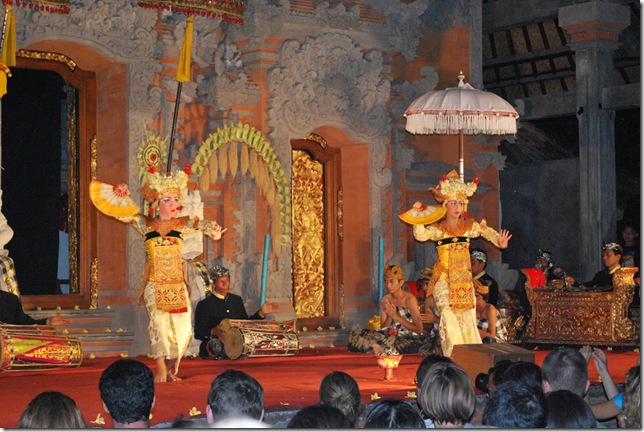 At least the costumes were great
At least the costumes were great
We were pretty tired after driving the scooter halfway across Bali so we found a basic warung dinner and a nearby hotel. The hotel was just the first one we stopped at and aside from not having any electricity in our room much of the time it was pretty amazing. It was part of a family compound in the city that had several rooms built in different styles in a small three-story space. It felt something like a monastery with the stone stairs, decorative wooden doors, and small space, but each room was spacious and had a patio for enjoying breakfast. On the way in you walked past the partially open-walled rooms of the family that owned and ran the hotel. In the morning the family spaces were full of friends and relatives with large bowls of food and plenty of drinks to celebrate some sort of ceremony. It was so laid back that they didn’t bother to ask about money, name, or ID when we walked in and when I asked about breakfast they said it was “from 7am to whenever you get up.” The family compound with an onsite business was a theme in Ubud; we saw several beautiful ones as we walked one of the main streets looking at the variety of art – paintings, wood carvings, weavings, silver jewelry and crafts.
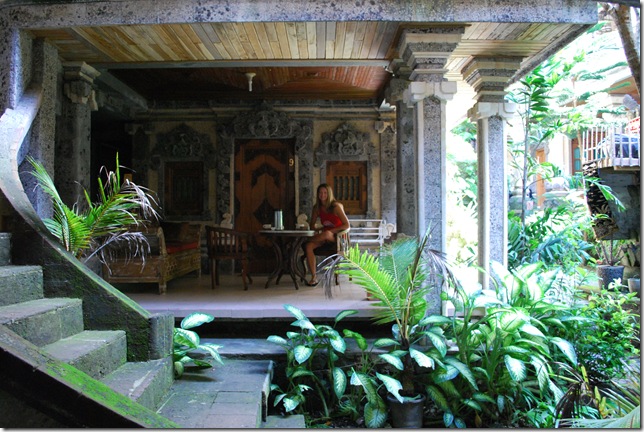 $20/night is a bit steep, but it looks great
$20/night is a bit steep, but it looks great
At the end of the street, aptly named Monkey Forest Road, we came to the Sacred Monkey Forest Sanctuary. The Monkey Forest is basically a small jungle area in the midst of an otherwise populated region where there are several temples and three troops of Balinese macaque monkeys. We bought some bananas to feed the monkeys and read that we weren’t to give the bananas directly to them, but to set them down for the monkeys to come and get. Apparently the monkeys haven’t read the brochure at the front desk. We were barely 10 paces down the forest path when a reasonably sized monkey spotted Lauren and her bunch of bananas. He strode quickly and smoothly toward her and then climbed up her leg and torso to grab a banana from her hand. She managed to stay pretty calm and only let out a couple of yells as the monkey darted to the edge of the path to chomp away. This scene was repeated several times. One of the trained monkey guardians actually had Lauren sit down and hold a banana up in one hand so the monkey would climb over her and onto her shoulder to take the banana. It all worked according to plan until the monkey came down off of her shoulder and into her lap on its way down. Being one of the sweetest and affectionate people around, and with a soft, furry monkey walking across her lap, Lauren just couldn’t resist the impulse to hug it. As she started to put her arm around it, the guardian yelled “Don’t touch monkey!”, startling both Lauren and the monkey, which had no intent of hanging around to snuggle. It took a while to stop laughing. I guess I was one up on all the tree-hugger types visiting Ubud; I came with my wife Lauren the great white monkey-hugger.
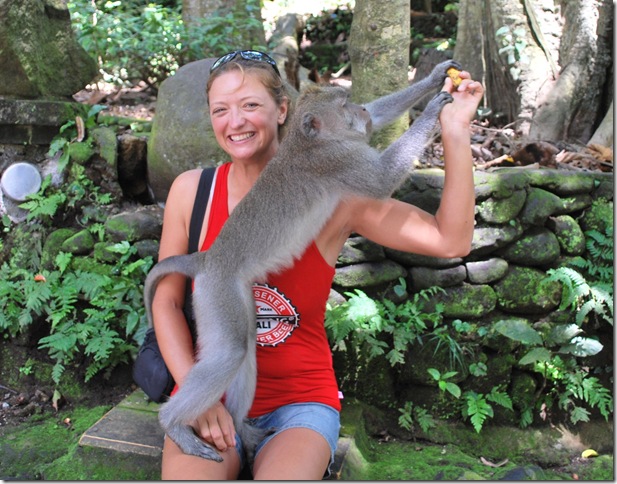 Little does this sweet little monkey suspect…
Little does this sweet little monkey suspect…
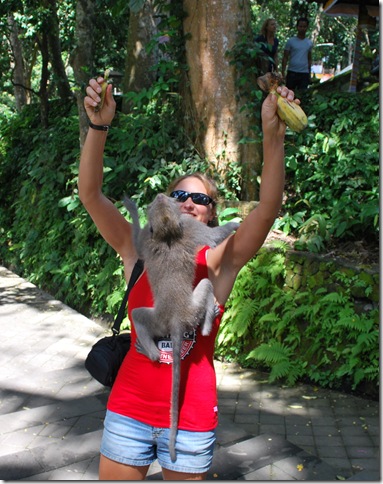 Ferns and banyan tree in background, monkey climbing banana tree in foreground
Ferns and banyan tree in background, monkey climbing banana tree in foreground
After several more episodes of monkeys climbing Lauren a.k.a. The Banana Tree, we started off on a walk through several villages and the countryside that was outlined in the Lonely Planet book. The walk was a great opportunity to see local villages, painters and wood carvers at work, and rice paddies in several states of maturity, from small shoots through to just-harvested stalks and plowed-under fields. We even came across a duck herder. I have no idea what the relationship between the villagers, the ducks, and the rice paddies is (aside from ducks eat stuff from the paddies and villagers eat ducks), but we came across a guy holding a long bamboo pole with plastic bags tied at one end. He was walking slowly through a rice paddy herding a large group of ducks, separating them into two groups and then moving one group across the road to another paddy. The ducks were some species of mallard and had either had their wings clipped so they couldn’t fly or were just used to being herded around. After another incredible dinner for less than $2/plate we found a room in a family compound nestled among the rice paddies at the edge of town. It didn’t look like much from a distance, but it was actually the nicest place we’ve stayed and had hot water as well.
We decided to give Balinese traditional dance one more try and went to a performance of the Kecak (KAY-chack) or Monkey Dance, which is a popular tourist attraction. This one was also on temple grounds, but outdoors in a circle on a large stone courtyard. The dance is a traditional story of love and war with the twist that the story features a large army of monkeys. The monkey army is represented by more than 50 men wearing a black and white checkered wrap with a red belt wrap. For most of the dance they sit in rows that form several concentric circles, although at times they stand, lay down, raise their arms, rock side to side, or move into different formations. A couple of the older men lead the chanting and singing. For most of the dance and play, which lasts more than 30 minutes, they make a the sound “chak-chak-chak” in unison — “chak-chak-chak-chak chak-chak-chak-chak chak-chak-chak-chak chak-a-chak”. You get the idea. Even though the dancing and acting were the same style and quality as the Legong dance, the Kecak was done around a firelight and to hear all the men chant and sing together makes a lasting impression.
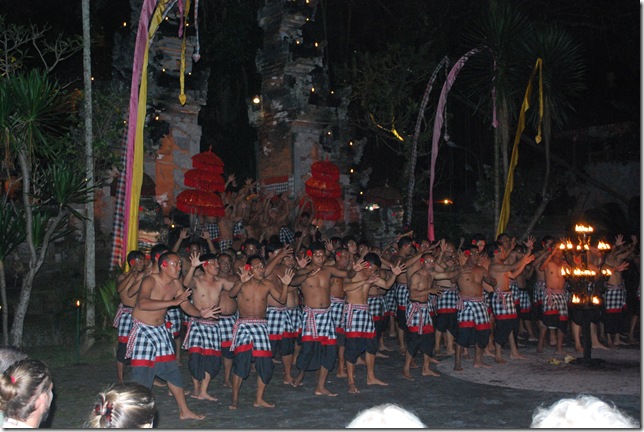 Kecak dancers entering the courtyard
Kecak dancers entering the courtyard
 Most of the Kecak dance/play was done with the men in a circle
Most of the Kecak dance/play was done with the men in a circle
After the Kecak dance, we were treated to a special horse trance fire dance. We didn’t really know what to expect, but figured it would be something like fire twirling dances in the Pacific. First the fires for the Kecak dance were put out and all the men formed several lines in the back of the open area. Then a man came out in the dark with a large box on a cart and dumped what sounded like a large pile of coconuts onto stone courtyard. A few seconds later he came back with a bottle of kerosene, poured it over the pile and then lit it on fire. We could now see that it was coconut husks and soon afterward a man came out dressed like the Kecak dancers but wearing a large hobby-horse contraption that fit over his shoulder and between his legs. He began to dance over the stone courtyard with his eyes closed. The left half of the men sang and chanted something similar to the Kecak song and chant and then the men on the right started to sing a different song. When the group of men on the right started singing, the barefoot hobby horse dancer turned and ran straight into the pile of burning coconut husks, kicking the glowing husks all over the courtyard, some landing only inches from the tourists in the front row! Needless to say, this got everyone’s attention. Two men came out with a wooden rakes and pushed the scattered and glowing husks back into a pile as the left group of men chanted. When the right group of men began to sing, the dancer again ran into the glowing pile of husks and kicked and scattered them. This was repeated a number of times before two men came out and caught the dancer, wrestling him to the ground and pulling the hobby horse contraption off of him. As soon as the horse was pulled off of him, the man collapsed in a seated position, a priest came out to sprinkle him with some water and he started praying. He was still sitting there with outstretched, blackened feet as we filed out of the temple grounds.
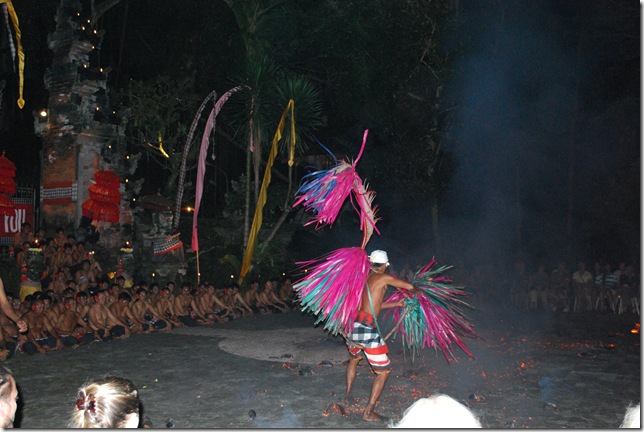 Fire dancer kicking and scattering the burning coconut husks
Fire dancer kicking and scattering the burning coconut husks


